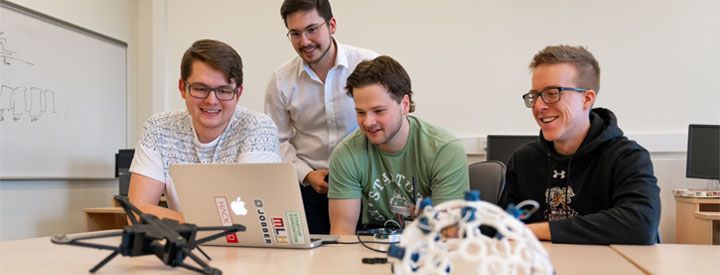Stephen Doyle, Alex Crowder, John Simmonds and Mark Reid employed an EEG cap to channel their thoughts into actions for the quadcopter, eventually getting the drone off the ground after numerous failed attempts. By the end of the project, the students had to tether the drone so it wouldn’t get too high and crash into the ceiling, but the operator needed to have a steady mind and clearly think about the concepts of “up” and “down” in order to maintain control over the device.
“It was the best feeling in the world just to see it work,” said John, referring to the first time the drone took off controlled by brainwaves. “Because we knew that regardless of what happened, we had done the work and would have gotten the grade at the end. But for ourselves, we wanted to see our project work. We wanted to see it go somewhere.”
The quartet came together in September 2018 to work on the ‘capstone’ project, a common course element in North American universities where students showcase all that they’ve learned up to that point. They realised they would have to incorporate knowledge from computer science, engineering and design, along with some basic neuroscience. In December, they presented their capstone project, ‘Analysis of Imagined Movement Using EEG’.

“An interesting outcome for this project was that every time the students got the drone to fly through thought, their excitement would in turn cause their mind to lose focus and the drone to crash,” explained Dr Jeffrey Davis, assistant professor in computer science at MacEwan. “It seems that emotion rather than thought may be the better way to fly the drone.”
While the four have no plans at the moment to continue their research, they say there is room for future students to pick up where they left off and to take an interdisciplinary approach by working with students in other faculties and departments to perfect the system and the drone.




Project to investigate hybrid approach to titanium manufacturing
What is this a hybrid of? Superplastic forming tends to be performed slowly as otherwise the behaviour is the hot creep that typifies hot...